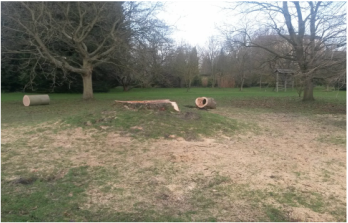
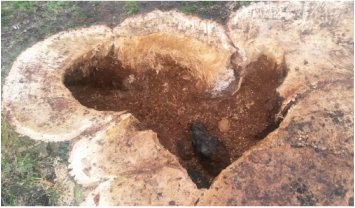
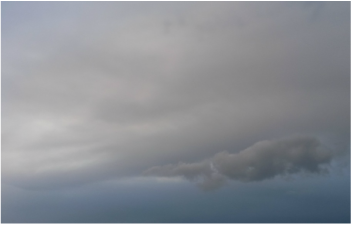
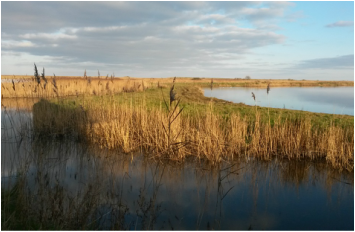
The Snow Geese is published as a Picador Classic in January. William Fiennes will take part in a Picador Classic day at Foyles, London WC2 on 7 February. Email [email protected]
|
|
|
The end of the month, the long year shrunk suddenly to a remnant. The weight of food and the warmth of family (if you can avoid arguments) combine with unaccustomed free time to give these days a gloss of significance. Our Christmas Day passes without incident. We remember last Christmas, most of us collected in Albert Street, then a couple of days in the cottage in Norfolk, finding Mum waiting with her coat on by the door each morning, bag packed, ready for home. I recall the morning I bullied her into a bath. This year, a less ambitious single day in Searle Street, marred only by the moment when she failed to recognise her son, and the small wet patch that remained on her chair after a game of Scrabble. We are left wondering if this will be our last Christmas with her.  My last visit to the Garden for the year coincided with a warning about essential tree works, the felling of a rotten tree near the Rose Garden. I head in that direction but am too late. Beyond the evergreens there’s a huge roughly circular area, perhaps 25 or 30 metres in diameter, covered with sawdust. The smell of newly cut wood hangs in the air. Two sections of trunk have been placed near the outer edges of the circle, ringside seats for a show that is already over. In the centre of the circle, the remains of the trunk stand a few inches clear of the ground on a raised mound. The stump is irregular in outline, its flat top mottled grey and pink, with a narrow broken band, almost white, just inside the layer of bark. One side of the stump is taken up with a dark heart-shaped hollow, partially filled with a reddish wood-dust and a knuckle of blackened branch. A darker area next to the hollow perhaps indicates the spread of the decay. One of the ‘seats’ is also rotten, almost half of the wood reduced to black dust where the trunk divides. It’s the size of the arena, though, which holds me there, its little cavities and hollows signs of the vast root system which supported this ‘tallest’ of trees.  Ailanthus altissima, native to China, is a fast grower with a short life. It’s a complex character, known as the ‘tree of heaven’ perhaps for its grace and stature or for its curative properties. It has been widely used in Chinese medicine, the earliest recorded recipes dating back to the seventh century. Different parts of the tree were used for different ailments: the roots (mixed with the urine of young boys) to treat mental illness, whilst the leaves were applied to the skin for relief from boils and abscesses, or to tackle baldness by stimulating hair growth. The bark is still figures prominently in modern Chinese medicine, used to treat conditions as various as asthma and epilepsy, cancer, dysentery and palpitations. The tree has a dark side, though. Its Chinese name means ‘foul-smelling tree’. And it’s an invader, with a suckering habit and an ability to suppress the competition, so that in many countries it’s classed as a noxious weed.  The shortest day past, we still have to rush to arrive in Norfolk in time for a walk before dark. We see a field of 40 or so Bewick swans; I learn that small heads and short necks are their distinguishing features. Two jays fly up on the edge of a wood, and a kestrel hovers at the roadside. A stoat ripples at speed across the road, its black-tipped tail a final flourish, then a muntjac. We pass five wild ponies, rough coats the washed-out colours of the wintry heath, and a flock of teal take to the air as we park. The pale sky is smudged with ash-grey. On Holme beach the tide is as far out as I’ve seen it, the white sands tinted a rusty pink. Not a breath of wind, we say, and immediately are proved wrong as we move out of the shelter of the dunes into a skin-shaving gust. We cut through marram grass onto the salt marsh, dodging patches of standing water, the ground a livid mix of russet and crimson, lime and emerald and sage, and then up through scratchy limbs of sea lavender onto the boardwalk and back through the pines. Driving home, we peer out in search of a short-eared owl rumoured to be hunting nearby as the last of the colour drains from the world but no joy.  We wake in the morning to a dusting of snow which quickly turns to sleety rain and a vicious wind. Dodging the worst of the weather, we head for Holkham in the hope of watching the geese come in to roost from the little tower that is the Joe Jordan hide. There are several trickles of pink-feet but not the huge numbers we expect. Still, there's the magic of straining the eyes towards what might be only an added graininess in the sky, until they materialise as dots which grow larger and more definite, the lines always shifting and rearranging themselves, filtering, shuffling themselves into one variation of their v-formation after another, never faltering, never crashing. We make our way back to the car, the hint of sound swelling to a constant chatter, at once plaintive and strident - William Fiennes has called it a ‘wild lung-top gabble’ - as more flocks come into land. It's an oddly thrilling noise which stays with me long after we've left Holkham and are home in front of a log fire. The following day the wind has vanished. The skies clear and warm sun coats Cley’s reed beds and salt marshes with a rosy glow. Waves crash and sparkle white, a flock of snow bunting bursts glittering upwards and away to the east; a perfect last Norfolk day for the year. The Snow Geese is published as a Picador Classic in January. William Fiennes will take part in a Picador Classic day at Foyles, London WC2 on 7 February. Email [email protected]
2 Comments
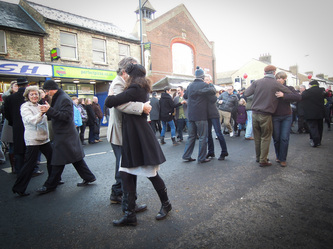 A wintry waking, frost on the glass roof of the kitchen extension, and a struggle to keep warm, even with extra socks and jumpers and the heating on repeat. It was cold on Saturday, too, but a fine day brought out the crowds for the Mill Road Winter Fair, even though the sun didn’t really make it through the houses. I joined thirty or so other members of Cambridge Tango for three quarters of an hour of dancing in the street in our hats and coats and street shoes and the warm embrace of friends, negotiating the crowds and trying not to slide into the gutter: great fun. Less fun I’m sure to be asking passing strangers for money for you and your dog – imagine having to survive outside in this weather, Liz said. Even for many with a roof over their heads, this winter promises still more punishment ahead, with Osborne’s record cuts set to return us to 1930s levels of public spending and benefit sanctions forcing many to resort to food banks. Archbishop of Canterbury Justin Welby was shocked by the ‘stark picture’ painted by a new church-funded enquiry: ‘hunger stalks large parts of our country’, he said. And a report from the Organisation for Economic Cooperation and Development highlights the widening wealth gap: the richest 10% of the population now earns 9.5 times the income of the poorest 10%, up from seven times in the 1980s. A claim from a government spokesman that 93% of benefits are paid on time will be cold comfort for the hungry. 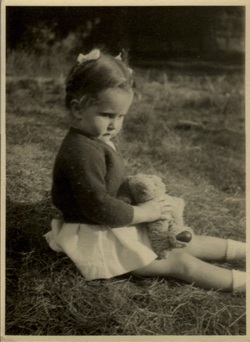 Comfort of a different kind comes from the sense of a journey shared. Di and I are mapping memory. We met almost 25 years ago in Carlisle, an artist and a writer, each recognising in the other a fellow fish out of water in that northern outpost, and have been friends since then. Now, although we live mostly on opposite sides of the Channel, we manage to meet fairly regularly to chart our progress. Our task: to find ways of representing our separate paths and their intersections, overlaps and divergences over the years. The challenge: how to show our several ‘maps’ at the same time – or is it in the same place? We began with the notion of a 3-D construction in clear Perspex. We have progressed as far as cardboard discs of our ‘worlds’ which we imagine hanging one above the other (which above which, though?) Meanwhile, we have collected and compared objects and photos, and made audio recordings of conversations and readings. It’s beginning to feel like a life’s work, intensely personal but also, we hope, with some wider relevance. And we write, our memories linked chronologically (‘childhood’, ‘teens’) or by location (Paris, London) or theme – currently we’re somewhere between railway journeys and gardens. 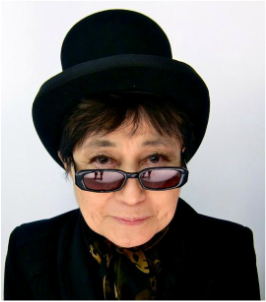 Which is where I should be, of course, out in the raw cold, trying still to figure out what exactly it is about this living world which endlessly fascinates. Instead, I’m stuck inside waiting for the delivery-that-never-comes, beset by echoes and distractions, of which of course there are plenty. Bob Dylan’s words ‘Stuck inside of Mobile with the Memphis Blues again’ gnaw at the periphery of my consciousness, so that suddenly I’m listening to the original 1966 recording (I was 16, a year before I saw Dylan live for the first time, Di 21). In true distraction mode, I wonder about the ‘meanings’ here, and find myself rerouted to an odd live recording from 2009, two years after I last saw him on stage (comments range from ‘legend’ to ‘wow don’t bother to turn up’) and thence to John Lennon, who apparently penned a spoof version mocking Dylan’s needlessly obscure lyrics. 34 years and a day since Lennon was killed, so Twitter sends me to the 1963 Royal Variety Performance of ‘Twist and Shout’, followed by the ‘official’ video of ‘Imagine’ and, by a circuitous route, to an interview with Yoko Ono, recorded I think last year as she turned 80. Whatever you think of Yoko and her work, here is someone who, like Dylan, is still growing, creating, reinventing. Still very much an activist, her answer to the inevitable retirement question ‘I never thought of it’, she’s a great advert for a productive and fulfilling later life, claiming that ’70 was great, 80’s even better’. Di and I were both intrigued and moved by her exhibition ‘To the Light’ at the Serpentine two years ago, the modest interactive ‘Where do we go from here?’ chiming nicely with our wanderings. 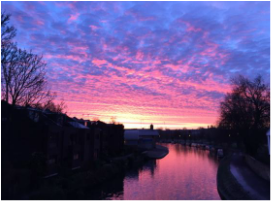 Sunrise over the Cam: Sophia Wickham Sunrise over the Cam: Sophia Wickham At last the UPS man comes and goes, and I get to step outside into wintry sunshine. I’m much too late for the ‘rosy-fingered dawn’ first recorded by Homer and illustrated beautifully by many photos appearing on Twitter this morning. But there’s a pale sun in a sky streaked with lemon and cream. The air is icy enough for me to wonder why I’ve come out without a hat; even the crowd of ducks and pigeons standing by the lock look cold. I cycle along the river, thinking about other people’s outings – Carole who takes herself off for a long walk every Sunday, Rose on her daily circuit of river and fen – and other people’s words for winter. It’s too early for Donne’s ‘midnight’ and for Hardy’s ‘weakening eye of day’, although the intricate tracery of bare branches reminds me of his ‘tangled bine-stems’. I have a head full of birdsong, too. Mark Cocker’s Claxton was on my reading pile this morning but his Guardian column beat me to it, his wonderful description of goldfinch song, ‘like flakes of gold metal held on threads… a filigree music’ sending me scouring the internet for a recording. 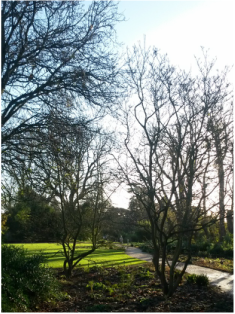 The following morning I head off to the Botanics. The grim forecast has again failed to materialise – a cool stiff breeze rather than the promised gusts and gales. The sky is a clear grainy blue, the sun warm. I’m not the safest cyclist & I have to be careful not to be too distracted by silhouettes of trees against the sky but there are plenty of such treats when I arrive at the garden. I love the way trees come into their own at this time of year. Some – Platycarya strobilacea from the walnut family and the big-leafed oak Quercus canariensis – have retained their leaves, though I’m not sure why. Some have that smattering still which makes them look as if they have decorated themselves with tissue paper cut-outs for Christmas. I have to remind myself that trees are their own creatures and, unlike Di and myself, have no problem with the third dimension or even, according to Mabey, the fourth dimension of time. We could learn from them: they are, simply and without fuss, at once their past and their present. Ali Smith’s How to be Both tackles this notion of simultaneity head-on, with humour, without sentimentality – and, yes, it’s heartening: if past & present do somehow coexist, like early versions of a fresco which are still there beneath the ‘finished’ painting, then what is lost is not lost, or not entirely, if we learn to look – we will, in fact, ‘always’ have Paris. I’m thinking comfort in the guise of coffee as I arrive at the café, smiling as I recall a lovely moment from the weekend’s party, captured I believe on video, of my favourite tango dancer caught up in an impromptu salsa lesson, sliding out of his habitual grace into veritable granddad-dancing – well and truly out of his comfort zone. And as I order my cappuccino I think of the difference which Cambridge’s own Wintercomfort makes to the lives of the city’s most vulnerable. |
At HomeAs Writer in Residence, thoughts from the garden Archives
October 2020
Categories |